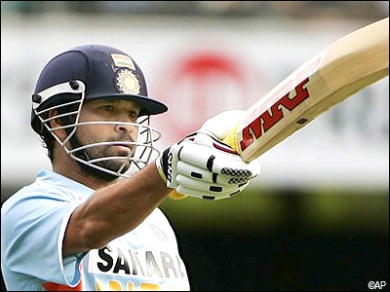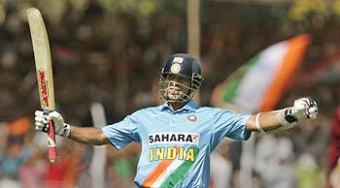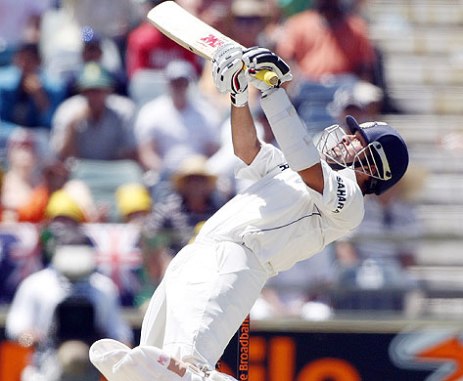This article first appeared in DNA on 11 Oct 2013 in two parts: Part-1 and Part-2
I once had the opportunity to travel from Mumbai to Singapore with Raj Singh Dungarpur. He was on his way to New Zealand as a representative of the BCCI at an ICC meeting. During our conversation, I asked him what his best decision was. Almost before I could finish my question he said, “Selecting Sachin Tendulkar to play for India,” and added with a twinkle in his eye, “although if you had seen him play as often I had, it wasn’t really a risky decision. It was bold, but not risky. And mark my words, any investment in Tendulkar will always pay off.”

Raj Singh Dungarpur, Akash Lal, Ramesh Saxena, Gundappa Viswanath and Naren Tamhane selected a young, bright-eyed, squeaky-voiced, curly-haired teenager to represent India in Pakistan. A young and determined 16-year old Sachin Tendulkar played against a tough Pakistan team on 15 November 1989; a Pakistan team that had three genuine pace bowlers (in Wasim Akram, Wakar Younis and Imran Khan) and a world-class leg-spinner (in Abdul Qadir).
Almost twenty four years after that bold decision, Tendulkar will retire from International cricket after having played 200 Test matches.
And in these 24 years, almost as often as we have heard the chant “Saaaaaachin Saaaaaachin” we have also had Tendulkar embody the very essence of the argumentative Indian. Rahul Bhattacharya captures this beautifully in his piece “Man-child superstar” in which he writes:
“If the strokes are flowing, spectators feel something beyond pleasure. They feel something like gratitude. The silence that greets his dismissal is about the loudest sound in sport. With Tendulkar the discussion is not how he got out, but why. Susceptible to left-arm spin? To the inswinger? To the big occasion? The issue is not about whether it was good or not, but where does it rank? A Tendulkar innings is never over when it is over. It is simply a basis for negotiation. He might be behind headphones or helmet, but outside people are talking, shouting, fighting, conceding, bargaining, waiting. He is a national habit.”
*****
Tendulkar never promised us that he would lead India to victory in every match he played. Yet, we wanted him to. No. We expected him to. No. We made him mortal if he did not. We expected more from Tendulkar than we did, from even our politicians.
Tendulkar never promised that, at 40, he would produce the fluent strokes he played when he was 28. Yet, we always expected ‘the Tendulkar of old’ or ‘the Tendulkar of 1998’. We could, of course, purchase a DVD of the famous ‘Desert Storm’ series and see that Tendulkar of old. But that wasn’t enough. It was as though even time stood still when we evaluated Tendulkar. We could not accept an ageing Tendulkar and watch the Tendulkar of now. For the argumentative Indian, if Tendulkar did not reproduce his shots from 1998, he did not deserve to be in the team in 2013.
Tendulkar himself never promised us that all his centuries would be made in ‘winning causes’. Yet we expected his centuries to always result in India wins (or else those centuries wouldn’t count, or we labeled him a selfish cricketer).
Tendulkar himself never claimed he was God. But, we made him God and then the rest of us brought him down. Bit by bit.
In the end analysis though, in a country that is somewhat bereft of (sporting) heroes, Tendulkar, the hero, has outlasted the argumentative Indian, crafted a career without a single blemish and stood as a beacon of hope and a giver of pleasure.
Perhaps that is the mark of (his) greatness in the Indian context. Greatness in sport in India is perhaps not defined by the heady confluence of elegance, balance, poise, grace, technique, focus, determination, power, dominance, imperiousness, confidence, occasional arrogance, consistency, longevity, awareness and intent. He has been all of that over a long career. He has had all of those qualities over an extensive and distinguished career. Perhaps greatness in the Indian sporting context has to be marked by violent disagreements on the very essence of that greatness; what exactly that greatness is about. His greatness should have been automatically assured. Yet in India, Tendulkar has always polarized opinion. And that, perhaps, ought to be the accepted definition of greatness in a country that needs heroes but is equally eager to tear them down and ‘cut them down to size’ every now and then.
*****
Sachin Tendulkar announced his retirement from all forms of cricket on Thursday, 10-10-2013. The fact that he had always worn the Number 10 India jersey may have had something to do with the timing of his retirement on this day. Or maybe it was the TEN that prefixed his surname which, in turn, may have earned him the number 10 jersey early on in his career.
The one other date that may have worked better for him — from the point of view of the numbers — would have been 10-10-10. If he had retired on 10 October 2010, he may have retired some five years too early. Indeed, on that very day, he was 44 not out at Bangalore against the visiting Australians. He went on to make a beautifully crafted 214 in that match. If he had retired on 10-10-10, we would have also missed his majestic 146 that he made at Cape Town on 4 January 2011. That Cape Town knock was his last Test century although, after that, he did come close to the 3-figure mark on a few occasions: a 91 (against England at the Oval in 2011) a 94 (against West Indies in Mumbai in 2011), a beautifully crafted 73 (against Australia at the MCG in 2011) a 76 (against England at the Eden Gardens in 2012) and an 81 (against Australia at Chennai in 2013).
So, on 10-10-2013, he has, in my view, retired two years too early. I say that although I am confident that my view is going to be questioned quite soundly and ridiculed significantly.
But that is what you get when you have an opinion on Tendulkar. There is no middle ground. You are either pro- or anti-Tendulkar. He polarizes opinions like no other champion players does (particularly in India).
As Siddhartha Vaidyanathan says in a post on Tendulkar, “What pains me is how a large part of discourse on the Internet is so limited to black and white. You are apparently either for Sachin or against him. If you question his place in the side, you are a moron who has no right to express an opinion or an ignorant bum who has never held a bat in his life or someone with a vested interest.”
*****
For all talk that he didn’t care about numbers and statistics, numbers did seem to matter to the man; or at least to the people around him who had a stake in him — and many did. So the choice of 10-10-2013 to announce his retirement was possibly deliberately crafted and carefully constructed like the 241* he made in Sydney in January 2004.
Numbers may not have mattered to the man, but they did to the industry around the man. And there is an industry around the man; an industry that seems filled with brand merchants, product architects, advertising honchos and people who launch things.
Perhaps I ought to have said ‘there was an industry around him’.
I would, if I can bring myself to talk about God in the past tense.
I cannot. At least, not yet.
Numbers did seem to matter. He worked hard to get to that 200th Test. Whether he did so because he wanted to, himself, or because of the people who had invested in him who had a vested interest in prolonging his career, we will never know. But it had been an open secret for far too long that he would play on until his 200th Test and that that 200th Test would be played in India. Indeed, it was the worst kept secret in the Indian cricket landscape; an environment that seems to have a steady growth — and not a decline — in innuendo and secret handshakes and less and less of assured planning and fact.
That his retirement in a home series was engineered so blatantly by his cricket Board just makes the cricket world sit up again and wonder at the beast at the ICC table that we Indian fans have created; the ogre that we continually endure and support.
*****
So how did you feel when you heard of the news of Tendulkar’s retirement?
Me? Although I sensed, since the start of this year that Tendulkar would retire after his 200th Test and even though I was prepared for the announcement, I felt a numbness when I heard the news. I cannot imagine an India Test team without Tendulkar. I cannot quite bring myself to accept that someone else will now walk in at the fall of the second wicket.

There was always a calm sense of assurance that Sachin Tendulkar would walk to the middle at the fall of the second wicket; that he would walk down the pavilion steps (or ramp), look skyward, squeeze his eyes, walk purposefully to the wicket, take guard and perform his pre-stance box adjustment routine.
That was assurance. It gave me comfort.
And I cannot yet bring myself to accept that the now famous and always assuring pre-stance box-adjustment routine will now be replaced by the vigorous bat twirl and ‘inside of the helmet visor wipe’ routine that belongs to Virat Kohli.
That acceptance may happen too, only because it must.
Tendulkar had given me — and many others like me — much joy in the 1990s when India got routinely thrashed all around the world. He gave me cause to celebrate because of the way he played the game. His cricket was simple, uncomplicated and beautiful. His cricket was untainted and joyous. His cricket was pure.
I had watched with admiration and pride as he grew in stature: he was first a kid playing in the midst of grown-ups, then a boy, then a lad, then a man and then, a God in his country and then, a statesman in world cricket. He did not want to be a God, mind you. We made him God. And the same people who made him God cruelly called him Endulkar in 1996 2006 when he was going through a rough patch, as all human beings must (and do).
But that was us fans. This God did have clay feet. Sometimes.
In the end, however, there was only one constant. He had always played the beautiful game with the same wide-eyed enthusiasm. He only wanted to play. He knew no other life.
*****
I had watched him score 119* in Manchester. Yes, that innings that really announced his arrival on the world stage. I was in England in those days. A few months later, I moved to Australia and there, I watched every ball he faced when he made 148 in Sydney in January 1992 in the company of Ravi Shastri. But more importantly, a month later, I watched in awe, with pride and a growing sense of admiration as he braved the pace of Craig McDermott, Merv Hughes, Paul Rieffel, Mike Whitney and Tom Moody when he made 114 in Perth. I had watched the young boy grow up to be a man and then, a legend. All in the space of 18 months. During that defining Perth innings, a boy wonder had become a man. That is, to date, the best innings I have watched Tendulkar play.
Or is it?
Was it that 241* in Sydney in 2004? Or the 111 in Johannesburg in November 1992? Or the 177 in Nottingham in 1996? Or the 169 in Cape Town in 1997? Or the 155* against Australia in Chennai in 1998? Or the 155 in Bloemfontein in 2001? Or the 193 in Leeds in 2002? Or the 194* in Multan in 2004? Or the 154* in Sydney in that Test in 2008?
There are too many wonderful knocks to list. But talk about the best Tendulkar innings always polarizes opinions, like talk about the man himself. And that is what you get by having an opinion on Tendulkar. There is no unique answer. Was that 241* his best or was it that 194*?
Perhaps that is the point about greatness. We can’t quit agree on what constitutes greatness, although there can’t be much doubt on greatness itself.
*****
And then there were the endless debates on whether Tendulkar played for himself or for his team. Siddhartha Vaidyanathan wrote on “Tendulkar and the ‘clutch’ question” in which he quotes his friend Jay, who said: “Most fans agree on what is a big game and what is not. There comes a time during these big games when most fans smell the moment, the moment when the game is balancing on the finest of threads. I have seen Tendulkar occasionally sense the moment and pounce on it, imposing his greatness on the occasion. But I feel I’ve seen him not seize these moments more often.”
Perhaps these arguments would never have happened if Tendulkar had finished the game off and won that Chennai Test against Pakistan in 1999. What that ignores is that there were a whole bunch of players who could have stayed with and helped a bruised Tendulkar win that game for India.
Perhaps these arguments won’t have happened if Tendulkar hadn’t skied that McGrath bouncer in the 2003 World Cup final. What that ignores is that it was perhaps because of Tendulkar that India even reached the 2003 World Cup final.
Perhaps…
But that is also an integral part of Tendulkar’s greatness in a country that is only now getting used to thinking about greatness in cricket. Fans have to either criticize his 136 in Chennai against Pakistan for what he did not do, or celebrate it, for what he did.
*****
Many will say that Tendulkar had extended his stay; that he ought to have retired from all forms of the game on 2 April 2011. But he continued playing all three forms of the game after that day. It was not his responsibility to select himself in the team. To play was his choice; one we must always respect. He had earned it. But did we respect him? No. Arguments raged notwithstanding the fact that, of the four member middle-order who have retired in the last four years, India has only found stable and able replacements for Rahul Dravid (Cheteshwar Pujara) and VVS Laxman (Virat Kohli). Four years after his retirement, India still does not have a steady replacement for Sourav Ganguly after trying out Yuvraj Singh, Suresh Raina, S. Badrinath, Ajinkya Rahane and Ravindra Jadeja. All of these have only had mixed success.
Yet, we were keen to disrobe God although it was clearly the duty of the national selectors to have a chat to the man and talk to him about retirement — that is, if they wanted to replace him.
Did he overstay his welcome? No. As I indicated earlier, in my view, he still had a year or two of Test cricket left in him. The team has already seen the departure of Ganguly, Dravid, Laxman, Kumble and perhaps Sehwag and Zaheer Khan. These days, a team that loses all of its stalwarts in one fell swoop is called Australia which thought — somewhat arrogantly — that there is an endlessly rich talent pipeline that affords selectors the luxury of a brutal revolving door.
National sporting teams need to carefully nurture talent and this needs the hands of an artist and not the axe of a wood-chopper.
Of course, Tendulkar’s place in the Indian team has never really been questioned (even in 1996) except, perhaps marginally, in the last one year or so of his career. Tendulkar still seemed to love the game and every time he took the field, seemed to play the game with the same zest that I saw in Manchester some 22 years ago. And he can still hold that 2-down spot.
In his retirement announcement, Tendulkar says, “It’s hard for me to imagine a life without playing cricket because it’s all I have ever done since I was 11 years old.”
His job was to play. He knew nothing else.
*****
So, the debates will continue to rage. And I had one within 5 minutes of his retirement announcement. I thought that his best shot was the straight drive to a fast bowler. A colleague said it was the upper cut over the slips, back arched, eyes focused on ball, neck slightly inclined. Yet another said that it was the back foot drive through the covers. Another said it had to be the casual flick through deep square leg.

We could not arrive at a meaningful conclusion. Perhaps one is not necessary.
We moved instead, to a discussion on his best innings ever. 241*, 194*, 111, 177, 155*… An hour later, with no conclusion in sight, we moved on to his best ODI innings ever. And so the night meandered on.
When an international sportsperson plays for as long as Sachin Tendulkar has, it is hard — nay, almost impossible — to pick out one specific shot, one specific innings, one specific moment. All of them were perhaps equally brilliant. All of them were crafted carefully. But more importantly, all of them were played by a young, enthusiastic, curly haired lad who loved the game, loved playing for India and wanted nothing more than to give pleasure to the people who watched him play.
Today, a day after the announcement, the numbness is gone. The sadness is gone. I only feel pleasure. Pleasure that I watched it all — from 1989 to 2013. Pleasure that I argued about him. For him. Pleasure that he enhanced the appreciation I have for the game. Pleasure that he was there as a beacon of hope in 2000, a time when the match-fixing saga raged; a time when I thought I would abandon my support for the game I loved so much because I had learned that some of the men who played the game had played it to line their own pockets.
But then God was there. He did not know how to cheat or how to throw games. He could not be procured. And in the end, his love of the game is really the measure of his greatness. He played for the team always. He played for the fans who loved the game always. Throughout his life, he lived cocooned in the warm comfort of his home or on the cricket field. He knew of no other life other than cricket.
Meanwhile, the arguments will continue unabated…
— Mohan Krishnamoorthy (@mohank)
The author is an unabashed fan of cricket, tweets at @mohank and blogs at http://www.i3j3cricket.com and mohankaus.blogspot.com














